Enhancing Accessibility with Custom ADA Signs
In the realm of inclusive design and accessibility, Custom ADA Signs play a pivotal role in ensuring that public spaces are welcoming and navigable for everyone. ADA, or the Americans with Disabilities Act, mandates the use of specific signage to facilitate easy access and navigation for individuals with disabilities. While standard ADA signs are essential, customizing them goes a step further in creating a truly inclusive environment that caters to the unique needs of a particular space or business.
Understanding ADA Signage
The Americans with Disabilities Act, enacted in 1990, aims to eliminate discrimination against individuals with disabilities. Part of this legislation outlines specific requirements for signage in public spaces to ensure that people with disabilities can navigate spaces independently. ADA signs typically include raised lettering, Braille, and high-contrast colors to enhance visibility and touch readability.
The Importance of Customization
While standard ADA signs serve a fundamental purpose, customizing them allows businesses and organizations to address specific needs and create a more cohesive and branded environment. Here are some key reasons why customization matters:
1. Branding and Aesthetics:
Custom ADA signs enable businesses to maintain a consistent brand image throughout their spaces. Incorporating brand colors, fonts, and logos into ADA signage ensures a visually cohesive and professional look that aligns with the overall aesthetic.
2. Space-specific Requirements:
Every space has its unique layout and requirements. Customizing ADA signs allows for tailoring the signage to the specific needs of a location, ensuring that individuals can navigate efficiently within that space.
3. Compliance with Local Regulations:
Custom ADA signs can be designed to comply with both federal and local accessibility regulations. By working with a knowledgeable signage provider, businesses can ensure that their customized signs meet all necessary legal requirements.
4. Enhancing Communication:
Customization enables businesses to convey specific messages beyond basic wayfinding. For instance, signs can include information about accessible features, emergency procedures, or specific amenities, offering a more informative and inclusive experience.
Choosing Materials and Finishes
Custom ADA signs can be created from a variety of materials, including acrylic, metal, and plastic. The choice of materials can impact the overall durability and appearance of the signs. Additionally, finishes such as matte, gloss, or textured surfaces can add a unique touch to the signage.
Working with a Professional Signage Provider
Creating effective custom ADA signs requires collaboration with a professional signage provider experienced in ADA compliance and customization. Such providers can offer guidance on design, materials, and installation, ensuring that the final product meets both aesthetic and regulatory standards.
Conclusion
Custom ADA signs are a powerful tool for businesses and organizations seeking to create an inclusive and welcoming environment for all. By combining accessibility with customization, these signs not only fulfill legal requirements but also contribute to a positive and cohesive brand experience. Investing in well-designed and tailored ADA signage is an investment in accessibility, inclusivity, and the overall success of a space.

.png)


Comments
Post a Comment